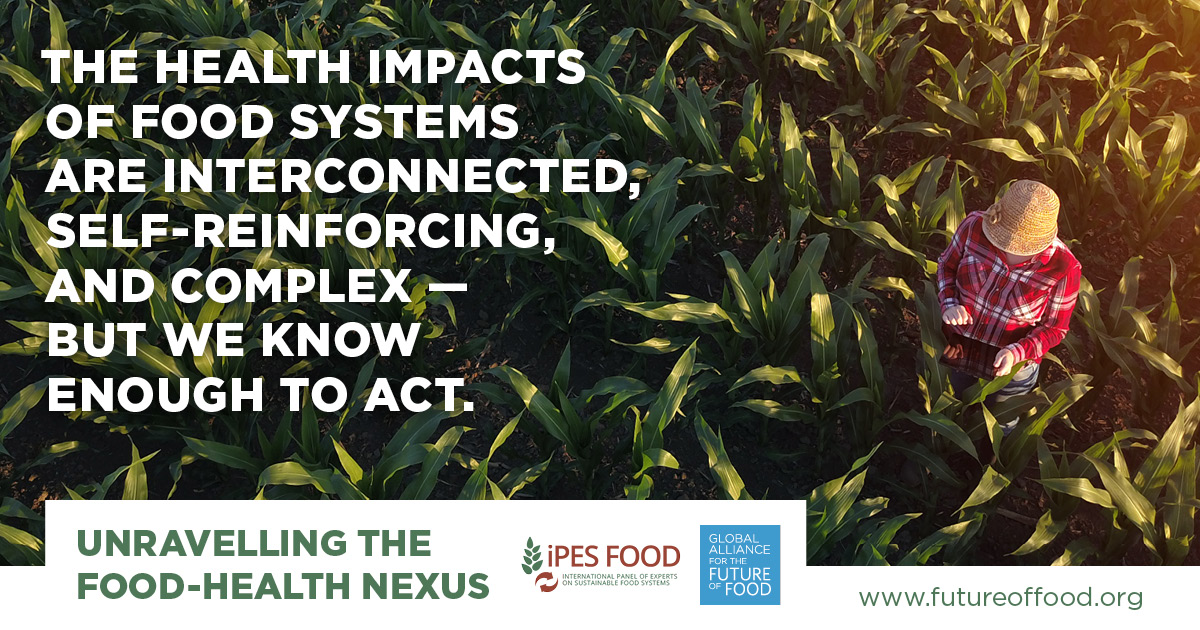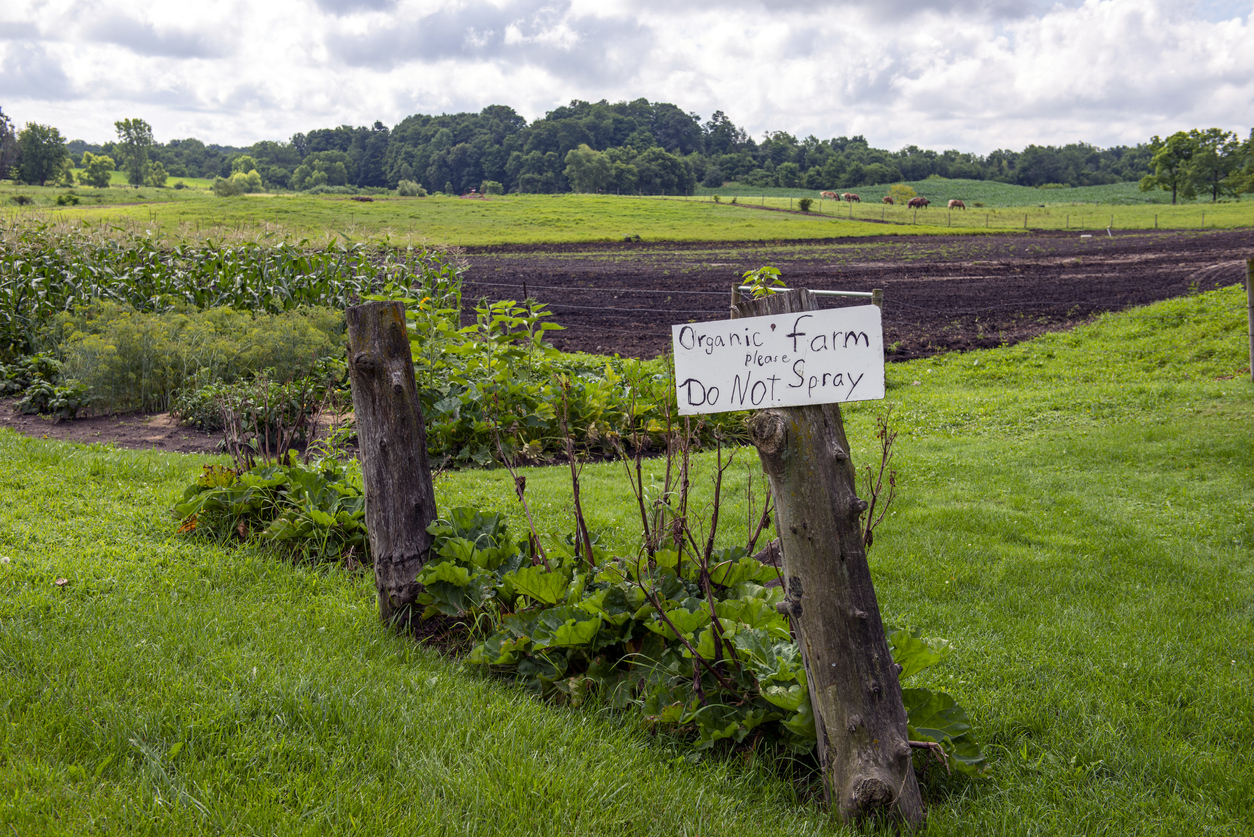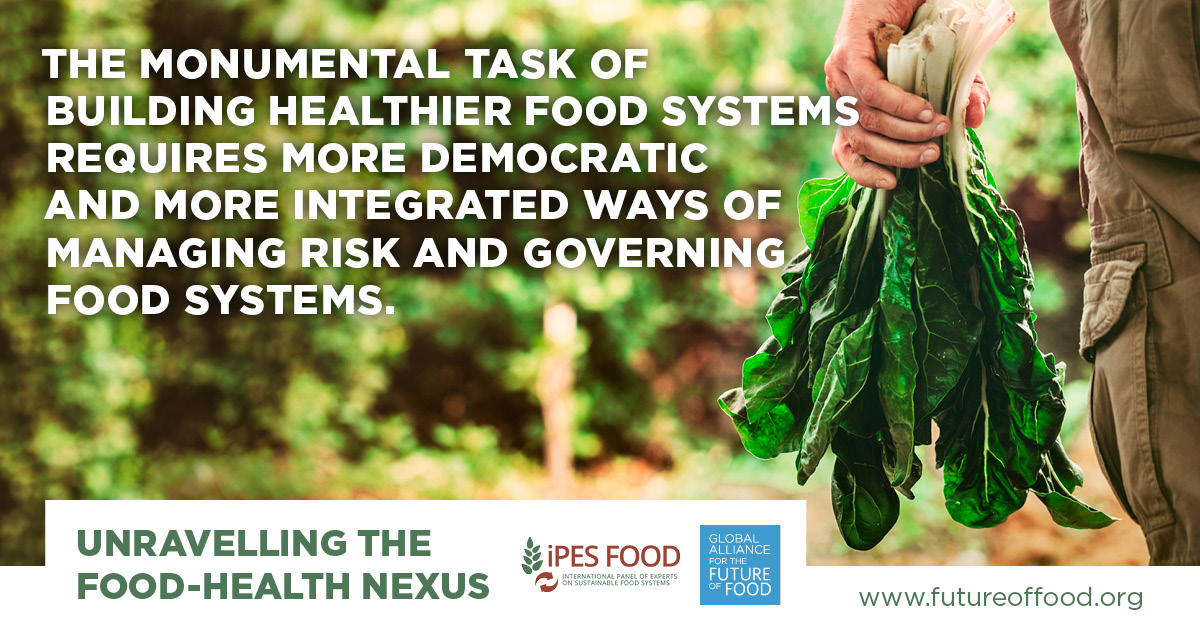
Share On Social!
The future of humanity depends on building healthier food systems.
Why?
Because our current food and farming systems make us sick in these ways:
- Unhealthy working conditions
- Contaminants in the water, soil, or air
- Specific foods are unsafe for consumption
- Unhealthy diets
- Lack of access to adequate, acceptable food
That is why the International Panel of Experts on Sustainable Food Systems (IPES Food) published a report to identify five leverage points for building healthier food systems.
1. Promote Food Systems Thinking
It’s time to overcome political and scientific silos. It’s time to reconnect people with the realities of the food on their plates.
The way food impacts health isn’t an isolated event.
We need to promote “food system thinking” where we view health impacts across the food system, and also globally assess the priorities, risks, and trade-offs underpinning our food systems.
To capture the full scope of the problem, light must be shed on the multiple connections between different health impacts:
- between human health and ecosystem health;
- between food, health, poverty, and climate change; and
- between social and environmental sustainability.
Additionally, the international dimensions of these health impacts must be recognized and systematically brought to light.
 Promoting understanding of the breadth of health impacts across food systems, and their links to underlying factors such as poverty and inequality, is crucial to weigh key trade-offs. This includes the provision of low-cost food versus the systematic poverty conditions faced by small-scale farmers and foodworkers, as well as the environmental fallout of the industrial model.
Promoting understanding of the breadth of health impacts across food systems, and their links to underlying factors such as poverty and inequality, is crucial to weigh key trade-offs. This includes the provision of low-cost food versus the systematic poverty conditions faced by small-scale farmers and foodworkers, as well as the environmental fallout of the industrial model.
2. Reassert Scientific Integrity and Research as a Public Good
Promoting food systems thinking is also critical to preserve scientific integrity.
“Less siloed and more systemic approaches in scientific and political discussion may make it harder for specific actors to continue to separate the problems from one another and to frame the debate around narrowly defined, one-dimensional solutions,” the report states.
Rather than allowing vested interest and reliance on private funding to shape scientific knowledge, research priorities and structures need to fundamentally align with principles of public interest and public good.
For example, changing the rules in scientific journals on disclosure of conflicts of interest can reduce potential bias in research and ensure information is clearer.
“Support could also be channeled to research and reporting that shines a light on industry-sponsored science, the role of industry front groups, and misinformation campaigns,” the IPES Food report states.
Participatory research, which includes the people whose health is most affected by food systems, can help to overcome narrow research questions that exclude impacts on certain populations.
Investment in large-scale data gathering by intergovernmental organizations could also draw attention to negative health impacts and to redress imbalances in availability of regional data.
3. Bring Alternatives to Light
The intensive crop monocultures and industrial-scale feedlots that dominate our food systems are driving:
- environmental degradation
- loss of vital ecosystem services
- economic hardship for smallholders
- socio-economic inequities
- debilitating health impacts
- food insecurity.
Rather than continue building evidence against these harmful food systems, it is important to gather, compare, and communicate the positive health impacts of alternative food systems.
 “It is crucial to: document and communicate the potential of diversified agroecological systems to reconcile productivity gains, environmental resilience, social equity, and health benefits; strengthen yields on the basis of rehabilitating ecosystems (not at their expense); build nutrition on the basis of access to diverse foods; and, redistribute power and reduce inequalities in process,” the IPES Food report states.
“It is crucial to: document and communicate the potential of diversified agroecological systems to reconcile productivity gains, environmental resilience, social equity, and health benefits; strengthen yields on the basis of rehabilitating ecosystems (not at their expense); build nutrition on the basis of access to diverse foods; and, redistribute power and reduce inequalities in process,” the IPES Food report states.
Documentation of these benefits and real-life experimentation on how to overcome political economy obstacles at the policy level are needed to support food system alternatives.
For example, IPES Food developed seven case studies with concrete examples of people around the world who are transitioning to alternative food systems.
“A solid information base on alternative food systems — how they perform, and how they can be effectively promoted through policy — can challenge the assumption that an ever-more industrial logic is the only solution for addressing health impacts in food systems,” the report states.
4. Adopt the Precautionary Principle
The health impacts of food systems are caused by many agents. These often reinforce each other through various mechanisms, thus cannot be easily singled out.
“It is thus inappropriate to look for a solitary, unique, and definite cause for these conditions, or to set a benchmark of ‘scientifically incontestable evidence’ (like for single-cause diseases) as a basis for action in food systems,” the IPES Food report states.
Rather than focusing on the single-cause model for the study of disease and basis for action, policymakers should consider multiple social and environmental risk factors acting together.
The precautionary principle (PP) lowers the threshold for action by governments when preliminary scientific evaluation indicates that there are reasonable grounds for concern, but scientific evidence is insufficient, inconclusive, or uncertain.
It requires policymakers to weigh the collective evidence from many different studies from many different disciplines and act according.
“Where there are threats to serious or irreversible damage, lack of full certainty shall not be used as a reason for postponing cost-effective measures to prevent environmental degradation and human health risks,” the report states.
5. Build Integrated Food Policies Under Participatory Governance
The monumental task of building healthier food systems requires more democratic and more integrated ways of governing food systems.
Rather than relying on simplistic and often biased traditional policy processes, integrated food policy processes are needed to align with the objective of delivering environmentally, socially, and economically sustainable food systems.
 Because many health impacts and their costs fall disproportionately on the poor and communities of color, such as Latinos, food policies must capture trade-offs and unlock the food-health-poverty nexus.
Because many health impacts and their costs fall disproportionately on the poor and communities of color, such as Latinos, food policies must capture trade-offs and unlock the food-health-poverty nexus.
For example, Full Cost Accounting or True Cost Accounting approaches can help to bring to light the true cost of cheap food, and to consider if these costs fall disproportionately on those living in poverty.
That why these processes must be participatory.
Greater stakeholder participation—policymakers, big and small private sector firms, healthcare providers, environmental groups, consumers’ and health advocates, farmers, agri-food workers, and citizens—in governance is needed to guarantee policy that is driven not only by evidence, but also by ethics and the broader public interest.
Governance mechanisms must find institutional ways to include populations who are disproportionately burdened.
What Can We Do?
Broader public awareness of and engagement with health risks in food systems is crucial to generate a greater understanding and acceptance of the basis on which decisions are being taken.
Read the IPES Food Report, Unravelling the Food-Health Nexus: Addressing Practices, Political Economy, and Power Relations to Build Healthier Food Systems.
Make sure you learn exactly why our food systems are making us sick.
Then spread the word about how we can work together to build healthier food systems:
- We need to promote “food system thinking” where we view health impacts across the food system, and also globally assess the priorities, risks, and trade-offs underpinning our food systems. #FoodSystems4Health #TrueCostAccounting salud.to/healthyag
- Rather than allowing vested interest and reliance on private funding to shape scientific knowledge, research priorities and structures need to fundamentally align with principles of public interest and public good. #FoodSystems4Health salud.to/healthyag
- It is important to gather, compare, and communicate the positive health impacts of alternative food systems. #FoodSystems4Health #TrueCostAccounting salud.to/healthyag
- Rather than focusing on the single-cause model for the study of disease and basis for action, policymakers should consider multiple social and environmental risk factors acting together. #FoodSystems4Health salud.to/healthyag
- The monumental task of building healthier food systems requires more democratic and more integrated ways of managing risk and governing food systems. #FoodSystems4Health salud.to/healthyag
We also urge you to get involved for the health of your community!
And no matter what topic you are interested in, be sure to download the Salud America! The Health Equity Report Card. The Report Card auto-generates local data with interactive maps and gauges, which can help you visualize health inequities in housing, transit, poverty, health care, healthy food, and other health equity issues compared to the rest of your state and nation.
You can email your Health Equity Report Card, share it on social media, and use it to make the case for community change to boost health equity, where everyone has a fair, just opportunity to live their healthiest.
By The Numbers
1
Supermarket
for every Latino neighborhood, compared to 3 for every non-Latino neighborhood



